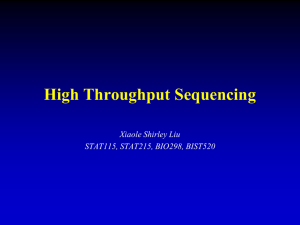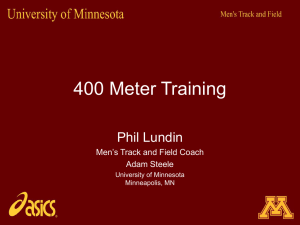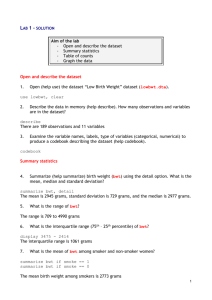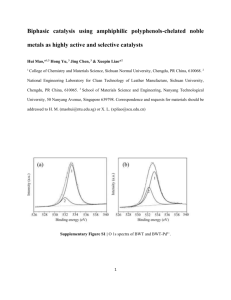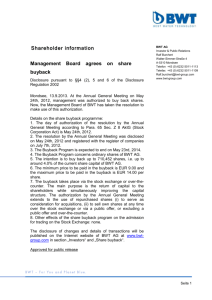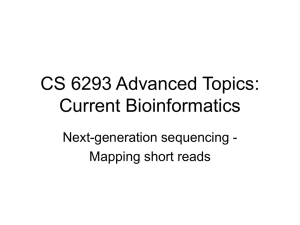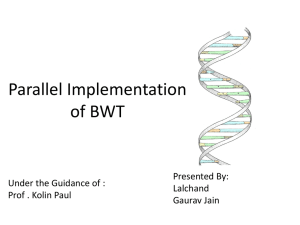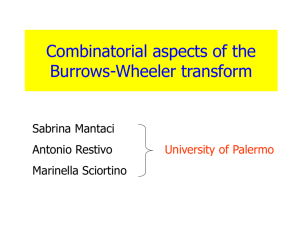7.36/7.91 recitation DG Lectures 5 & 6 2/26/14
advertisement
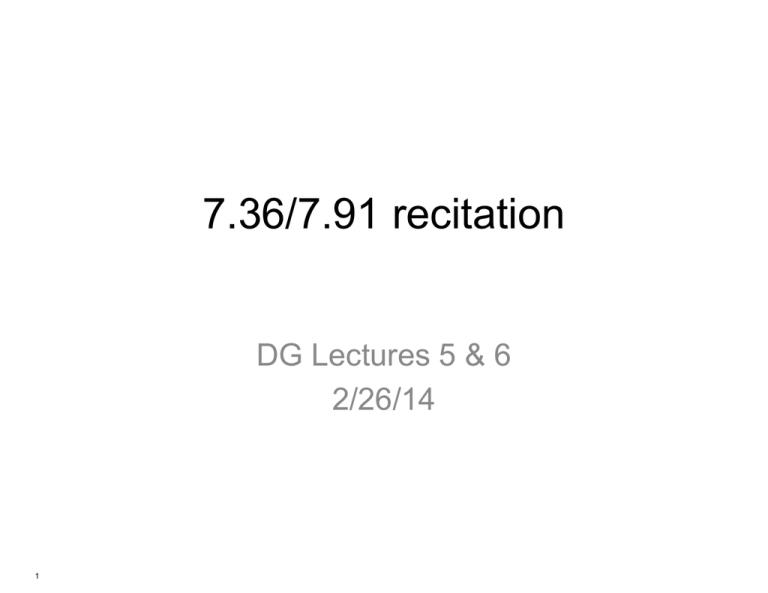
7.36/7.91 recitation
DG Lectures 5 & 6
2/26/14
1
Announcements
• project specific aims due in a little more
than a week (March 7)
• Pset #2 due March 13, start early!
• Today:
– library complexity
– BWT and read mapping
– de Bruijn graphs
2
Library Complexity
• You isolate DNA from your sample of interest (genomic
DNA, ChIP-seq, cDNA from RNA-seq, etc.)
• You go through a protocol to generate a “library” of sizeselected molecules (e.g. 200-300bp for paired-end
genomic DNA sample, much smaller from ChIP-seq, etc.)
– Library is only a subset of your original sample – some
molecules have been lost due to:
• 1. Stochastic sampling (molecules w/ low count are often lost)
• 2. Systematic exclusion at steps of the library prep. protocol
• The number of UNIQUE molecules in your library is
known as “library complexity”, C (total # of molecules T is
>> C due to PCR amplification during library prep.)
• The number of sequencing reads you get back is N (<T
since only a subset of reads in the library cluster on the
flow cell and are sequenced)
3
Library Complexity: Naïve approach
• Assume each unique molecule is represented equally in the library
– Not a terrible assumption for genomic DNA (but still not true due to PCR
amplification bias)
– Definitely not a true for ChIP-seq, RNA-seq, etc. in which most frequent
molecules in the sample (millions of copies) will have certain fragments
represented multiple times in the library even after random fragmentation
– Each molecule has prob. 1/C of being sequenced. You sequence N total
molecules, with M UNIQUE molecules in your sequencing run (M < N)
• # times each molecule in the library sequenced follows a Poisson distribution with mean
(= variance):
N
A=
C
• P(observing a molecule in sequencing output) =1 – P(sequencing the read 0 times) =
1
X
e-A
x=1
x!
x
e-A
=10!
• Maximum likelihood estimate of C is
Cˆ
0
= 1 - e-A
:
M = C ⇥ P (observing a molecule) =) Cˆ =
M
1- e-A
• Note that our formula for estimating C involves λ, but λ=N/C (it’s a function of what we’re
trying to estimate!). So this Poisson formula is not as simple as it appears…would likely
want to perform iterative estimation of these parameters.
4
Library Complexity: Naïve
approach
• Testing this against real data (e.g. subsampling) reveals the assumption
(each unique molecule is represented equally in the library) is totally off!
– Again, due to: 1. Stochastic sampling of sample molecules into library
– 2. Original highly expressed molecules are represented multiple times
– 3. PCR amplification bias of some molecules
• Thus, λ is not the same for every molecule, and we should allow it to vary
- This motivates using the Negative Binomial (2 parameters) instead of the
Poisson (1 parameter)
• Negative binomial distribution models an overdispersed Poisson
distribution: useful when the variance > mean (they’re equal in Poisson).
– The dispersion is k (this needs to be fit to data)
– Higher k more over-dispersed library more “biased” library and further
deviation from assumption that each unique molecule is represented equally
– Note that there are different parameterizations of the Negative Binomial: In terms
of (λ and k) or (r and p) in lecture slides, as well as whether r is the desired
success or the last failure. See http://www.johndcook.com/negative_binomial.pdf
- Use Wikipedia/Matlab/WolframAlpha for Problem Set
5
Short read alignment (mapping)
• Motivation: Common sequencing experiments:
~100 million 100bp reads to align to a billion base
pair genome
• Naïve (“ctrl-F” search) method of taking a read
and searching the entire genome:
– O(genome size = 1 billion) per read (without indels)
– For all reads: O(1 billion x 200 million) – infeasible!
– Ideally, something that approaches O(# of reads) –
approximately independent of the size of genome
• We do this through BWT transform and FM index
of genome
6
7
Why use the BWT?
we have grouped together
rotations of our "genome" by
their suffixes, and stored
information about this ordering
(the BWT)
e.g. all the rotations beginning with
"n with" are grouped together
© Digital Equipment Corporation. All rights reserved. This content isexcludedfrom our
Creative Commons license. For more information,see http://ocw.mit.edu/help/faq-fair-use/.
Source: Burrows, Michael, and David J. Wheeler. "A Block-sorting Lossless
Data Compression Algorithm." (1994).
8
BWT and character rank
notice that each column and each
row of the BW-matrix contains
every letter from the input string
rank?
1
1
2
3
1
1
2
9
rank?
$BANANA
A$BANAN
ANA$BAN
ANANA$B
BANANA$
NA$BANA
NANA$BA
A
N
N
B
$
A
A
Burrows
Wheeler
matrix
Burrows
Wheeler
transform
1
1
2
1
1
2
3
- what do we mean by a character's
rank in a column?
- the rank of a specific character qc is
the number of qcs above it in the
column, +1
- note that (for example) the "A" of
rank 2 in the last column (BWT) and
first column are the same lexical
occurrence (the A preceded by
"BAN" and followed by "NA")
- this lets us distinguish between the
different "A" characters that occur in
different contexts in the original string:
BANANA
rank in BWT?
3
2
1
- so, chars in the First and Last columns
have the same rank
10
Last to First (LF) function
LF(i, qc) = occ(qc) + count(i, qc)
returns the index of the char in the First column that is lexically
equivalent to the instance of qc in position i of the BWT, using the
fact that rank is same in First and Last columns
occ(qc) = # characters lexically smaller than qc
in the BWT (e.g. rank in First column of matrix)
idx
0
1
2
3
4
5
6
11
BWT
$BANANA
A$BANAN
ANA$BAN
ANANA$B
BANANA$
NA$BANA
NANA$BA
count(i,qc) = # of qc characters before position i
in the BWT (e.g. rank of qc character at position i,
minus 1)
In other words, since the first column is
alphabetical, we first find the row where our
character starts in the First column (e.g. Ns begin
at index 5), then use the fact that rank is same in
first and last column to find the specific char in First
col that is the same lexical occurrences as our
query in the BWT
Using the BWT and LF function to
do exact matching
• say we have the following sequence: $ABBABA, and we want
to find occurrences of BBA
• using the BW-matrix, we can start by finding all rows
beginning with "A"
but, we're only interested
in rows where the A is
preceded by a B
and now, we only want
suffixes where the B is
preceded by another B
Once we know where our
matches to our query begin in
the BWT, use LF to get these
locations in original string
To make this clearer, we showed the entire
BW matrix. But how to do this if we only
have the BWT?
- use the LF function!
http://www.cs.jhu.edu/~langmea/resources/lecture_notes/bwt_and_fm_index.pdf
12
13
Using the BWT and LF function to do exact matching
2
4
1) at end of loop, calculate range = bot – top
- if range == 1:
exactly one match at top
- if range = n > 1:
n matches of query at top to bot-1
- if range == 0:
query does not exist in genome
in our case, there are exactly two
occurrences of "ANA" in "BANANA"
2) how can we find the location of our matches in the original string?
- use LF function to walk back to the beginning of the string,
starting at the beginning of the identified match (= top)
- count # of times we "walk left" until hitting the end of string
char ($) to get the hit offset
14
Find location of our match
- let's find the location of one of the two matches we found,
corresponding to location 2 in the BWT:
- use LF to "walk back" from the beginning the match
("top") until we see the end-of-string character "$"
pseudocode:
i = top offset = 0
while BWT[i] != "$":
offset += 1
i = LF(i, BWT[i])
15
# final value of 'top' after matching
Find location of our match
let's find the location of one of the two matches we found,
corresponding to location i=2 in the BWT:
- use LF to "walk back" until we see the end-of-string char "$"
- obtain hit offset = 3
BANANA
16
17
Regenerating your string from its
BWT
same as using LF to walk-back to the beginning of the string and
get the hit offset, except you start from the end
- by definition, BWT[0] is the last character of original string
i = 0
str = ""
while bwt[i] != "$":
str = bwt[i] + str
i = LF(i, bwt[i])
0
1
2
3
4
5
6
7
18
A
N
N
B
$
A
A
iter 0:
i=0
str = ""
iter 1:
str = BWT[0] + str
= "A"
i = LF(0, "A") = 1
iter 4:
str = BWT[2] + str
= "NANA"
i = LF(2, "N") = 6
iter 2:
str = BWT[1] + str
= "NA"
i = LF(1, "N") = 5
iter 5:
str = BWT[6] + str
= "ANANA"
i = LF(6, "A") = 3
iter 3:
str = BWT[5] + str
= "ANA"
i = LF(5, "A") = 2
iter 6:
str = BWT[3] + str
= "BANANA"
i = LF(3, "B") = 4
BWT[4]
== "$"
DONE
Some caveats
• how to calculate occ(qc) and count(i,qc) when the genome is huge?
– for occ(qc), need only to know where each character in the genome
begins, for example as a dictionary in python:
occ = {"A": 1, "C": 345, "G": 768, "T": 981}
means there is only 1 char ("$") lexigraphically smaller than "A", there are
345 smaller than "C", 768 smaller than "G" etc.
– count(i,qc) is trickier – naïvely, you could store for each ACGT a genomelength array containing count(i, qc) at location i, but these would be huge!
Instead, store counts for only a subset of positions, then count # of qcs
between i and closest stored count
• similarly, the method we showed for recovering the offset of a match using the
LF function requires "walking back" to the beginning of the string – quite a long
time, using a whole genome!
– naïvely again, could keep genome-length mapping of BWT to original string
indices -> lookup table
– since genome is huge, instead store indices for every ith row
Together, these improvements comprise the FM-index
19
Genome Assembly (“shotgun sequencing”)
• First sequencing of human genome
– De novo assembly of sample from field work
• This is in contrast to most experiments in labs these
days in which you generally are mapping your
sequenced reads to the known reference genome of
yeast, C. elegans, mouse, human, etc.
• May be situations in which you don’t do full genome
assembly but partial assembly for reads that don’t map
to reference genome to discover, for example,
translocations, inversions, etc. in cancer tumor
samples
• Longer reads and more depth is better, but limited by:
– Experimental cost
– Errors in longer reads (higher errors from bases ~50
onward)
20
Two main approaches
• Overlap layout consensus (string graph)
– Plus: Retain entire read and its long-range
position implications
– Drawback: computationally expensive / slow
• de Bruijn graph
– Plus: Computationally more tractable
– Minus:
•
•
Graphs get messy (bubble, tips) and must use
heuristics to trace path through graph
Lose longer-range position information: have 100bp
reads and k=30
-Lose the fact that these two
30mers are separated by 40bp
21
Overlap graph
Overlap graph
Below: overlap graph, where an overlap is a suffix/prefix match
of at least 3 characters
• Each node is a read
A vertex is a read, a directed edge is an overlap between suffix of
source and prefix of sink
Vertices (reads): {suffix
a: CTCTAGGCC,
GCCCTCAAT,
c: CAATTTTT
}
– Directed edge is overlap between
of b:that
read
to prefix
of
{ (a, b),l)(b, c) }
Edges (overlaps):
another read (overlap at least
length
To keep our presentation
will not show
the only
– Also include reverse complements
ofuncluttered
readswesince
we
treatment of read reverse complements
sequence 1 of 2 strands of DNA
CTCTAGGCC
%%%%%%|||
%%%%%%GCCCTCAAT
GCCCTCAAT
%%%%%||||
%%%%%CAATTTTT
http://www.langmead-lab.org/teaching-materials/
http://www.langmead-lab.org/teaching-materials/
– To assemble the genome, we would ideally find the shortest
common superstring
• This is the shortest string that contains all relationships implied by the
overlap graph from all of the reads
• Finding a “Hamiltonian path” (traveling salesman problem) to visit all of
the nodes: turns out this is too complex of a problem to solve
• Greedy methods that will find not the shortest but close to shortest
(bounded by ~2.5x shortest)
– Greedy method makes the locally optimal choice at each step but doesn’t look
any further ahead to take steps that may lead to overall better solutions in the end
– Even if it were tractable, one problem with this approach is that
finding the shortest common superstring will collapse repeats
longer than your overlap
22
Layout
Overlap graph
Picture gets clearer after removing some transitively-inferrible
edges
• To simplify the graph, can remove edges that provide no additional
1
information
Layout
http://www.langmead-lab.org/teaching-materials/
http://www.langmead-lab.org/teaching-materials/
• This produces
contigs of consecutive sequence: each contig
Emit contigs corresponding to the non-branching stretches
corresponds to a clear path through part of the graph
23
From overlap graphs de Bruijn
graphs
• Overlap graphs: each kmer is a node
– Would like to visit each node once to assemble a
version of the genome
• Hamiltonian path through the graph
– However, this very hard (NP-hard) and
computationally does not scale to large genomes
• de Bruijn graphs: each kmer is an edge
– In contrast, the problem of visiting each edge
once to assemble a version of the genome is
computationally tractable
• Eulerian path through the graph
24
de Bruijn graph
• Choose k smaller than read length L
– Tradeoff:
• Smaller k loses more long-range information for
repetitive regions and could create spurious overlaps if
too small.
• But too large k could eliminate edges between truly
adjacent regions of genome if there are sequencing
errors and/or low coverage of region.
• Empirically, k is usually in 60s
• k is odd so that no read is its reverse complement
(middle base cannot be same in read and reverse
complement)
25
de Bruijn graph
• Choose k smaller than read length L
– Each read has L-k+1 kmers
• For each of these kmers, consider its
two (k-1)mers (prefix and suffix)
• These (k-1)mers are the nodes of the graph
• Connect the prefix (k-1)mer node to the
suffix (k-1)mer node with a directed arrow
• The edges are kmers from the input reads
– If a kmer is present in multiple times in your reads, can draw
one arrow weighted with the number of occurrences of that
kmer in all of the reads
26
de Bruijn graph
• Although computationally tractible, still are
practical problems
– Graph can have multiple walks through the
graph; only one corresponds to true path
– Gaps in coverage lead to disconnected graph
(can only assemble two contigs)
– Differences in coverage can lead to different #
of incoming and outgoing arrows
– Errors in reads
27
de Bruijn graph post-processing
• Before traversing the graph:
– Simplify chains
– Trim off ‘dead-end’ tips
– Pop bubbles
– Clip short, low-coverage nodes
28
de Bruijn graph post-processing
• Before traversing the graph:
– Simplify chains
The&graph&can&be&compressed&by&
• Collapse two nodes (or sets of nodes), one with only 1 outgoing
arrow andsimplifying&chains&of&nodes&
the other with only 1 incoming arrow, into one longer
node
CCG
TCC
CGA
AAG
AGA
CTC
GAC
ACT
GGA
GGGA&
TGG
CTCCGA&
CTCC&
GACT&
AAGA&
CTTT&
CTGG&
TTT
CTG
GGG
CCGA&
CTT
AAGA&
GACT&
CTTT&
CTGGGA&
Figure&adapted&from&presentaQon&by&Michael&Schatz&
Graph&topology&based&error&eorrecQon&
de Bruijn graph post-processing
– Errors&at&end&of&read&
B’&
• Trim&off&‘deadEend’&Qps&
A&
• Before traversing the graph:
&
A&
B&
B&
Simplify chains
– Trim off ‘dead-end’ tips
– Errors&in&middle&of&read&
B’&
•
Tip:
short
chain
of
nodes
that
is disconnected
on one
C&
A&
C&
• Pop&Bubbles&
A&
B*&
end
&
B&
h&topology&based&error&eorrecQon&
• Caused by sequencing errors in read
&
&
Pop bubbles
B’&
nd&of&read&
A&
B&
B&
–
Chimeric&Edges
&
A&
nodes
A&
‘deadEend’&Qps&Clip short, low-coverage
bles&
B&
C&
D&
x&
• Clip&short,&low&coverage&nodes&
B&
C&
middle&of&read&
A&
D&
Figure&adapted&from&presentaQon&by&Michael&Schatz&
B’&
A&
C&
A&
B*&
C&
de Bruijn graph post-processing
• Before traversing the graph:
Simplify chains
Trim off ‘dead-end’ tips
– Pop bubbles
• Bubble: two paths that are redundant by starting and
ending at the same nodes and contain similar
sequences
• Caused by sequencing error or biological variation
• More complicated heuristics of how to pop them; for
our purposes, manually inspect for sequencing error
and pop
Clip short, low-coverage nodes
31
de Bruijn graph post-processing
• Before traversing the graph:
Simplify chains
Trim off ‘dead-end’ tips
An&example&of&bubble&removal&
– Pop bubbles
ACTGGT
CTGGTG
TGGTGG
GGTGGG
GTGGGA
Clip short, low-coverage nodes
GACTGG
GACTCC
ACTGGG
GGACTC
CTGGGA
TGGGAC
GGGACT
If more reads support bottom path of
bubble
GACTGG
GACTCC
ACTGGG
GGACTC
CTGGGA
GGGACT
TGGGAC
ph&topology&based&error&eorrecQon&
de
Bruijn
graph
post-processing
t&end&of&read&
B’&
off&‘deadEend’&Qps&
A&
A&
B&
• Before traversing the graph:
B&
Simplify chains
Trim off ‘dead-end’
tips
n&middle&of&read&
B’&
A&
C&
ubbles&
B*&
Pop bubblesA&
B&
– Clip short, low-coverage
nodes
C&
• Low coverage means they’re probably erroneous
c&Edges&
A&
B&
A&
B&
C&
D&
x&
hort,&low&coverage&nodes&
C&
D&
Figure&adapted&from&presentaQon&by&Michael&Schatz&
de Bruijn graph
• Although some information is lost in de
Bruijn graphs, they are fast and simple
– Most commonly-used assemblers are de
Bruijn graph-based
Nature Biotech primer on de Bruijn graphs:
http://www.cs.ucdavis.edu/~gusfield/cs225w12/deBruijn.pdf
34
MIT OpenCourseWare
http://ocw.mit.edu
7.91J / 20.490J / 20.390J / 7.36J / 6.802 / 6.874 / HST.506 Foundations of Computational and Systems Biology
Spring 2014
For information about citing these materials or our Terms of Use, visit: http://ocw.mit.edu/terms.
